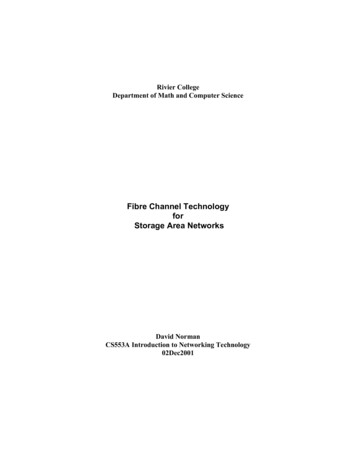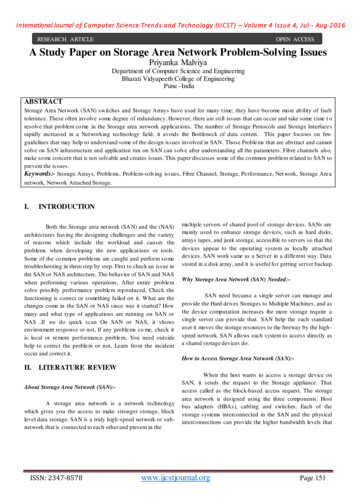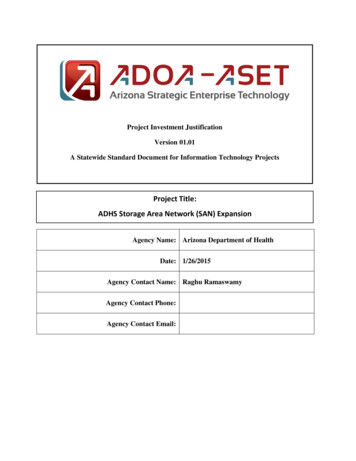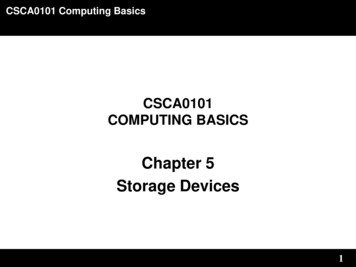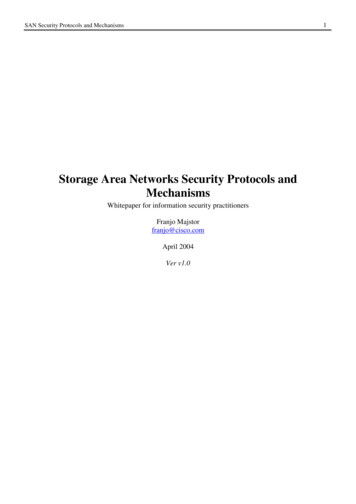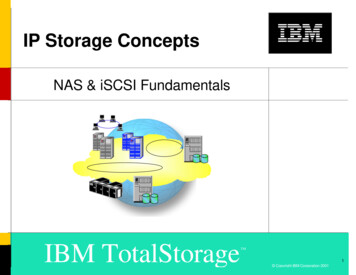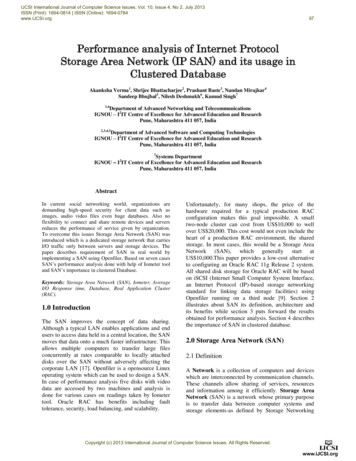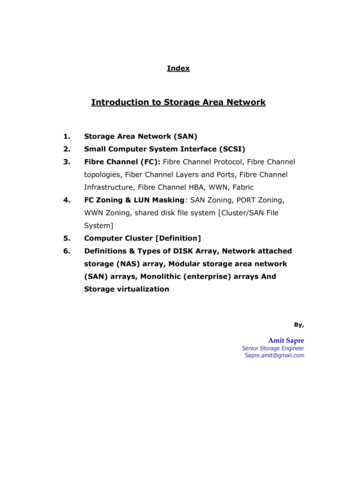
Transcription
IndexIntroduction to Storage Area Network1.Storage Area Network (SAN)2.Small Computer System Interface (SCSI)3.Fibre Channel (FC): Fibre Channel Protocol, Fibre Channeltopologies, Fiber Channel Layers and Ports, Fibre ChannelInfrastructure, Fibre Channel HBA, WWN, Fabric4.FC Zoning & LUN Masking: SAN Zoning, PORT Zoning,WWN Zoning, shared disk file system [Cluster/SAN FileSystem]5.Computer Cluster [Definition]6.Definitions & Types of DISK Array, Network attachedstorage (NAS) array, Modular storage area network(SAN) arrays, Monolithic (enterprise) arrays AndStorage virtualizationBy,Amit SapreSenior Storage EngineerSapre.amit@gmail.com
Storage area networkA storage area network (SAN) is architecture to attach remote computerstorage devices (such as disk arrays, tape libraries and optical jukeboxes) to serversin such a way that, to the operating system, the devices appear as locally attached.[By contrast to a SAN, Network Attached Storage (NAS) uses file-based protocolssuch as NFS or SMB/CIFS where it is clear that the storage is remote, and computersrequest a portion of an abstract file rather than a disk block.]Definition of SANA storage area network (SAN) is a high-speed special-purpose network (or subnetwork) that interconnects different kinds of data storage devices with associateddata servers on behalf of a larger network of users. Typically, a storage area networkis part of the overall network of computing resources for an enterprise. A storagearea network is usually clustered in close proximity to other computing resourcessuch as IBM z990 mainframes but may also extend to remote locations for backupand archival storage, using wide area network carrier technologies such as ATM orSONET.TypesMost storage networks use the SCSI protocol for communication between serversand disk drive devices. However, they do not use SCSI low-level physical interface(e.g. cables), as its bus topology is unsuitable for networking. To form a network, amapping layer is used to other low-level protocols: "iFCP"[1] or "SANoIP"[2] mapping SCSI over Fibre Channel Protocol (FCP) overIP.iSCSI, mapping SCSI over TCP/IP.iSER, mapping iSCSI over InfiniBand (IB).HyperSCSI, mapping SCSI over Ethernet.FICON mapping over Fibre Channel (used by mainframe computers).ATA over Ethernet, mapping ATA over Ethernet.Fibre Channel over EthernetSCSI (pronounced skuzzy)Small Computer System Interface is a set of standards for physically connectingand transferring data between computers and peripheral devices. The SCSIstandards define commands, protocols, and electrical and optical interfaces. SCSI ismost commonly used for hard disks and tape drives, but it can connect a wide rangeof other devices, including scanners and CD drives. The SCSI standard definescommand sets for specific peripheral device types; the presence of "unknown" asone of these types means that in theory it can be used as an interface to almost anydevice, but the standard is highly pragmatic and addressed toward commercialrequirements. SCSI is an intelligent interface: it hides the complexity of physical format.Every device attaches to the SCSI bus in a similar manner.
SCSI is a peripheral interface: up to 8 or 16 devices can be attached to asingle bus. There can be any number of hosts and peripheral devices butthere should be at least one host. SCSI is a buffered interface: it uses hand shake signals between devices,SCSI-1, SCSI-2 have the option of parity error checking. Starting with SCSIU160 (part of SCSI-3) all commands and data is error checked by a CRC32checksum. SCSI is a peer to peer interface: the SCSI protocol defines, communicationfrom host to host, host to a peripheral device, peripheral device to aperipheral device. However most peripheral devices are exclusively SCSItargets, incapable of acting as SCSI initiators—unable to initiate SCSItransactions themselves. Therefore peripheral-to-peripheral communicationsare uncommon, but possible in most SCSI applications. The NCR53C810 chipis an example of a PCI host interface that can act as a SCSI target.[SCSI (Small Computer System Interface) is a set of ANSI standards for connectingdevices to computer systems. The vast majority of SCSI devices are data storagedevices.Standard SCSI is a parallel technology, but many serial SCSI variants exist, includingFireWire and Fibre Channel.SCSI is generally considered a higher-end alternative to IDE (Integrated DriveElectronics). A single IDE controller can control two drives. A single SCI controllercan control 8 or 16 drives. In addition, SCSI usually offers greater cable length andhigher length than IDE.]SCSI StandardsSCSI StandardCable Length Speed (MBps) Devices SupportedSCSI-1658SCSI-265-108 or 16Fast SCSI-2310-208Wide SCSI-232016Fast Wide SCSI-232016Ultra SCSI-3,8-bit1.5208Ultra SCSI-3,16-bit1.54016Ultra-2 SCSI12408Wide Ultra-2 SCSI12801616016Ultra-3 (Ultra160/m) SCSI 12Fibre ChannelFibre Channel, or FC, is a gigabit-speed network technology primarily used forstorage networking. Fibre Channel is standardized in the T11 Technical Committee ofthe International Committee for Information Technology Standards (INCITS), an
American National Standards Institute (ANSI)–accredited standards committee. Itstarted use primarily in the supercomputer field, but has become the standardconnection type for storage area networks (SAN) in enterprise storage. Despitecommon connotations of its name, Fibre Channel signaling can run on both twistedpair copper wire and fiber-optic cables; said another way, fiber (ending in "er")always denotes an optical connection, whereas fibre (ending in "re") is always thespelling used in "fibre channel" and denotes a physical connection which may or maynot be optical.Fibre Channel Protocol (FCP) is the interface protocol of SCSI on the FibreChannel.Fibre Channel started in 1985, with ANSI standard approval in 1994, as a way tosimplify the HIPPI system then in use for similar roles. HIPPI used a massive 50-paircable with bulky connectors, and had limited cable lengths. Fibre Channel wasprimarily concerned with simplifying the connections and increasing distances, asopposed to increasing speeds. Later, designers added the goals of connecting SCSIdisk storage, providing higher speeds and far greater numbers of connected devices.It also added support for any number of "upper layer" protocols, including SCSI,ATM, and IP, with SCSI being the predominant usage.Fibre Channel VariantsNAMELine-Rate (Gbit/s) Throughput ( 010GFC Serial10.51875100020GFC10.52200010GFC Parallel 12.75
Fibre Channel topologiesThere are three major Fibre Channel topologies, describing how a number of portsare connected together. A port in Fibre Channel terminology is any entity thatactively communicates over the network, not necessarily a hardware port. Port isusually implemented in a device such as disk storage, an HBA on a server or a FibreChannel switch. Point-to-Point (FC-P2P). Two devices are connected back to back. This isthe simplest topology, with limited connectivity. Arbitrated loop (FC-AL). In this design, all devices are in a loop or ring,similar to token ring networking. Adding or removing a device from the loopcauses all activity on the loop to be interrupted. The failure of one devicecauses a break in the ring. Fibre Channel hubs exist to connect multipledevices together and may bypass failed ports. A loop may also be made bycabling each port to the next in a ring.o A minimal loop containing only two ports, while appearing to be similarto FC-P2P, differs considerably in terms of the protocol.Switched fabric (FC-SW). All devices or loops of devices are connected toFibre Channel switches, similar conceptually to modern Ethernetimplementations. The switches manage the state of the fabric, providingoptimized interconnections. Point-toPointAttributeArbitrated loopSwitchedfabricMax ports2127 16777216(224)Address sizeN/A8-bit ALPA24-bit port IDSide effect of portfailureN/ALoop fails (until portbypassed)N/AMixing different linkratesN/ANoYesFrame deliveryIn orderIn orderNot guaranteedAccess to mediumDedicatedArbitratedDedicated
FC-Topologies ImageFibre Channel layersFibre Channel is a layered protocol. It consists of 5 layers, namely: FC0 The physical layer, which includes cables, fiber optics, connectors,pinouts etc.FC1 The data link layer, which implements the 8b/10b encoding and decodingof signals.FC2 The network layer, defined by the FC-PI-2 standard, consists of the coreof Fibre Channel, and defines the main protocols.FC3 The common services layer, a thin layer that could eventually implementfunctions like encryption or RAID.FC4 The Protocol Mapping layer. Layer in which other protocols, such asSCSI, are encapsulated into an information unit for delivery to FC2.FC0, FC1, and FC2 are also known as FC-PH, the physical layers of fibre channel.Fibre Channel routers operate up to FC4 level (i.e. they are in fact SCSI routers),switches up to FC2, and hubs on FC0 only.Fibre Channel products are available at 1 Gbit/s, 2 Gbit/s, 4 Gbit/s, 8 Gbit/s, 10Gbit/s and 20 Gbit/s. Products based on the 1, 2, 4 and 8 Gbit/s standards should beinteroperable, and backward compatible. The 10 Gbit/s standard (and 20 Gbit/sderivative), however, is not backward compatible with any of the slower speeddevices, as it differs considerably on FC1 level (64b/66b encoding instead of 8b/10bencoding). 10 GB and 20 GB Fibre Channel is primarily deployed as a high-speed"stacking" interconnect to link multiple switches.
PortsThe following types of ports are defined by Fibre Channel: node portso N port is a port on the node (e.g. host or storage device) used witheither FC-P2P or FC-SW topologies. Also known as Node port.o NL port is a port on the node used with an FC-AL topology. Alsoknown as Node Loop port.switch/router ports (used with FC-SW topology only)o F port is a port on the switch that connects to a node point-to-point(i.e. connects to an N port). Also known as Fabric port. An F port isnot loop capable.o FL port is a port on the switch that connects to a FC-AL loop (i.e. toNL ports). Also known as Fabric Loop port. Note that a switch portmay automatically become either an F port or an FL port dependingon what is connected.o E port is the connection between two fibre channel switches. Alsoknown as an Expansion port. When E ports between two switchesform a link, that link is referred to as an inter-switch link (ISL).o EX port is the connection between a fibre channel router and a fibrechannel switch. On the side of the switch it looks like a normal E port,but on the side of the router it is a EX port.o TE port is a term used for multiple E ports trunked together tocreate high bandwidth between switches. Also known as TrunkingExpansion port.general (catch-all) typeso G port or generic port on a switch can operate as an E port orF port.o L port is the loose term used for any arbitrated loop port, NL port orFL port. Also known as Loop port.o U port is the loose term used for any arbitrated port. Also known asUniversal port.LC (left) and SC (right) optic fiber connectors
Fibre Channel InfrastructureFibre Channel switches are divided into two classes. These classes are not part of thestandard, and the classification of every switch is a marketing decision of themanufacturer. Directors offer a high port-count in a modular (slot-based) chassis with nosingle point of failure (high availability). Switches are typically smaller, fixed-configuration (sometimes semimodular), less redundant devices.Brocade, Cisco and QLogic provide both directors and switches.If multiple switch vendors are used in the same fabric (i.e. fabric is heterogeneous),the fabric will default to "interoperability mode", that is to a pure standardized FibreChannel protocol. Some proprietary, advanced features may be disabled.Fibre Channel Host Bus AdaptersFibre Channel HBAs are available for all major open systems, computerarchitectures, and buses, including PCI and SBus (obsolete today). Some are OSdependent. Each HBA has a unique World Wide Name (WWN), which is similar to anEthernet MAC address in that it uses an Organizationally Unique Identifier (OUI)assigned by the IEEE. However, WWNs are longer (8 bytes). There are two types ofWWNs on a HBA; a node WWN (WWNN), which is shared by all ports on a host busadapter, and a port WWN (WWPN), which is unique to each port. Some FibreChannel HBA manufacturers are Emulex, LSI, QLogic and ATTO Technology.Today, the term host bus adapter (HBA) is most often used to refer to a FibreChannel interface card. Fibre Channel HBAs are available for all major open systems,computer architectures, and buses, including PCI and SBus (obsolete today). EachHBA has a unique World Wide Name (WWN), which is similar to an Ethernet MACaddress in that it uses an OUI assigned by the IEEE. However, WWNs are longer (8bytes). There are two types of WWNs on a HBA; a node WWN, which is shared by allports on a host bus adapter, and a port WWN, which is unique to each port. MajorHBA manufacturers are Emulex, QLogic, LSI, and ATTO Technology. There are HBAmodels from different speed: 2Gbit/s, 4Gbit/s and 8Gbit/s.[HOST ADAPTER: In computer hardware, a host controller, host adapter, or host busadapter (HBA) connects a host system (the computer) to other network and storagedevices. The terms are primarily used to refer to devices for connecting SCSI, FibreChannel and eSATA devices, but devices for connecting to IDE, Ethernet, FireWire,USB and other systems may also be called host adapters. Recently, the advent ofiSCSI has brought about Ethernet HBAs, which are different from Ethernet NICs inthat they include hardware iSCSI-dedicated TCP Offload Engines.]World Wide NameA World Wide Name (WWN) or World Wide Identifier (WWID) is a unique identifierin a Fibre Channel or Serial Attached SCSI storage network. Each WWN is an 8-byte
number derived from an IEEE OUI (for the first 3 bytes) and vendor-suppliedinformation (for the rest).There are two formats of WWN defined by the IEEE: Original format: addresses are assigned to manufacturers by the IEEEstandards committee, and are built into the device at build time, similar toEthernet MAC address. First 2 bytes are either hex 10:00 or 2x:xx (where thex's are vendor-specified) followed by the 3-byte vendor identifier and 3 bytesfor a vendor-specified serial numberNew addressing schema: first half-byte is either hex 5 or 6 followed by a 3byte vendor identifier and 4 bytes and a half for a vendor-specified serialnumberList of a few WWN company identifiers 00:50:76 IBM00:a0:98 NetApp00:60:69 Brocade Communications Systems00:05:1E Brocade Communications Systems, formerly owned by RhapsodyNetworks00:60:DF Brocade Communications Systems, formerly CNT TechnologiesCorporation00:E0:8B QLogic HBAs, original identifier space00:1B:32 QLogic HBAs. new identifier space starting to be used in 200700:C0:DD QLogic FC switches00:90:66 QLogic formerly Troika Networks00:11:75 QLogic formerly PathScale, Inc08:00:88 Brocade Communications Systems, formerly McDATA Corporation.WWIDs begin with 1000.08000:60:B0 Hewlett-Packard - Integrity and HP9000 servers. WWIDs begin with5006.0b000:11:0A Hewlett-Packard - ProLiant servers. Formerly Compaq. WWIDsbegin with 5001.10a00:01:FE Hewlett-Packard - EVA disk arrays. Formerly Digital EquipmentCorporation. WWIDs begin with 5000.1fe100:17:A4 Hewlett-Packard - MSL tape libraries. Formerly Global DataServices. WWIDs begin with 200x.0017.a400:60:48 EMC, for Symmetrix00:60:16 EMC, for CLARiiONFibre Channel fabricA Fibre Channel fabric (or Fibre Channel switched fabric, FC-SW) is a switchedfabric of Fibre Channel devices enabled by a Fibre Channel switch. Fabrics arenormally subdivided by Fibre Channel zoning. Each fabric has a name server andprovides other services.Fibre Channel zoningIn storage networking, Fibre Channel zoning is the partitioning of a Fibre Channelfabric into smaller subsets to restrict interference, add security, and to simplify
management. If a SAN contains several storage devices, each system connected tothe SAN should not be allowed to interact with all of them. Zoning applies only to theswitched fabric topology (FC-SW); it does not exist in simpler Fibre Channeltopologies.Zoning is sometimes confused with LUN masking, because it serves the same goals.LUN masking, however, works on Fibre Channel level 4 (i.e. on SCSI level), whilezoning works on level 2. This allows zoning to be implemented on switches, whereasLUN masking is performed on endpoint devices - host adapters or disk arraycontrollers.Zoning is also different from VSANs, in that each port can be a member of multiplezones, but only one VSAN. VSAN (similarly to VLAN) is in fact a separate network(separate sub-fabric), with its own fabric services (including its own separatezoning).There are two main methods of zoning, hard and soft, that combine with two sets ofattributes, name and port.Soft zoning restricts only the fabric name services, to show the device only anallowed subset of devices. Therefore, when a server looks at the content of thefabric, it will only see the devices it is allowed to see. However, any server can stillattempt to contact any device on the network by address. In this way, soft zoning issimilar to the computing concept of security through obscurity.In contrast, hard zoning restricts actual communication across a fabric. Thisrequires efficient hardware implementation (frame filtering) in the fabric switches,but is much more secure.Zoning can also be applied to either switch ports or end-station name. Port zoningrestricts ports from talking to unauthorized ports. Because this is non-standard, itusually requires a homogeneous SAN (all switches from one vendor). Any deviceplugged in a specific physical switch port is given access to the zone. Name zoningrestricts access by device's World Wide Name. This is more flexible, but WWNs canbe spoofed, reducing security.Currently, the combination of hard and name zoning is the most popular.Example topology of a Fibre Channel switched fabric network
What is LUN masking?LUN (Logical Unit Number) Masking is an authorization process that makes a LUNavailable to some hosts and unavailable to other hosts.LUN Masking is implemented primarily at the HBA (Host Bus Adapter) level. LUNMasking implemented at this level is vulnerable to any attack that compromises theHBA.Some storage controllers also support LUN Masking.LUN Masking is important because Windows based servers attempt to write volumelabels to all available LUN's. This can render the LUN's unusable by other operatingsystems and can result in dataWhat is SAN zoning?SAN zoning is a method of arranging Fibre Channel devices into logical groups overthe physical configuration of the fabric.SAN zoning may be utilized to implement compartmentalization of data for securitypurposes.Each device in a SAN may be placed into multiple zones.What is port zoning?Port zoning utilizes physical ports to define security zones. A users accessto data is determined by what physical port he or she is connected to.With port zoning, zone information must be updated every time a user changesswitch ports. In addition, port zoning does not allow zones to overlap.Port zoning is normally implemented using hard zoning, but could also beimplemented using soft zoning.What is WWN zoning?WWN zoning uses name servers in the switches to either allow or block access toparticular World Wide Names (WWNs) in the fabric.A major advantage of WWN zoning is the ability to recable the fabric without havingto redo the zone information.WWN zoning is susceptible to unauthorized access, as the zone can be bypassed if anattacker is able to spoof the World Wide Name of an authorized HBA.
Shared disk file systemA shared disk file system, also known as cluster file system or SAN filesystem, is an enterprise storage file system which can be shared (concurrentlyaccessed for reading and writing) by multiple computers. Such devices are usuallyclustered servers, which connect to the underlying block device over an externalstorage device. Such a device is commonly a storage area network (SAN).Shared disk file systems are necessary because with regular file systems, if multipleinstances were to attempt concurrent access to the same physical device, the datawould rapidly become corrupt, because there is nothing to prevent two devices fromperforming a modification of the same part of the file system at the same time.Computer clusterA computer cluster is a group of coupled computers that work together closely sothat in many respects they can be viewed as though they are a single computer. Thecomponents of a cluster are commonly, but not always, connected to each otherthrough fast local area networks. Clusters are usually deployed to improveperformance and/or availability over that provided by a single computer, whiletypically being much more cost-effective than single computers of comparable speedor availability.Disk arrayA disk array is a disk storage system which contains multiple disk drives. It isdifferentiated from a disk enclosure, in that an array has cache memory andadvanced functionality, like RAID and virtualization.Components of a typical disk array include: Disk array controllersCache memoriesDisk enclosuresPower suppliesTypically a disk array provides increased availability, resiliency and maintainability byusing additional, redundant components (controllers, power supplies, fans, etc.),often up to the point when all single points of failure (SPOFs) are eliminated from thedesign. Additionally those components are often hot-swappable.Typically, disk arrays are divided into five categories: NAS, Modular SAN arrays,Monolithic SAN arrays, Storage Virtualization and Utility SAN Arrays.Network attached storage (NAS) arraysNetwork attached storage is a hard disk storage system on a network with its ownLAN IP address. NAS arrays provide file-level access to storage through suchprotocols as CIFS and NFS. Examples: 3PAR and ONStor UtiliCat Unified Storage
EMC Celerra familyHP StorageWorks All-In-One Storage SystemsHP ProLiant' Storage ServerNetApp FilerSun StorageTek 5000 familyModular storage area network (SAN) arraysA SAN is a dedicated network, separate from LANs and WANs, that is generally usedto connect numerous storage resources to one or many servers. SAN arrays provideblock-level access to storage through SCSI-based protocols such as Fibre Channeland iSCSI. Modular storage system typically consists of separate modules, whichafford some level of scalability, and can be mounted, in a standard rack cabinet.Modular storage systems are also sometimes referred as departmental. Examples: 3PAR InServ E-ClassEMC CLARiiONFujitsu ETERNUS 4000/3000 series storage arraysHP Storageworks EVA family productsHitachi Thunder family productsIBM DS4000/FAStT family of storage serversIBM DS6000 series storage serversArena Maxtronic Janus Fibre Channel and iSCSI RAID systemsInfortrend EonStor/EonRAID familyNetApp FAS series Unified storage serversONStor PanteraSun StorageTek 6x40Xiotech Magnitude 3DMonolithic (enterprise) arraysAlthough this is not a strict definition, the array is considered monolithic when evenbasic configuration is physically too large to fit into a standard rack cabinet. Thesearrays are suited for large-scale environments. Often Enterprise storage systemsprovide ESCON and FICON protocols for mainframes in addition to Fibre Channel andiSCSI for open systems SANs. Examples: EMC SymmetrixFujitsu ETERNUS 8000/6000 series storage arraysHitachi Lightning and TagmaStore USP family productsHP XPIBM Enterprise Storage Server (ESS)IBM DS8000 series of storage serversInfortrend EonStor / EonRAID familySun StorEdge 99xx (9970, 9980, 9985, 9990)Storage virtualizationIntelligent SAN or Storage Servers (Software that adds disk controller functionality tostandard server hardware platforms). Hardware independent software that typicallyruns as a control program on top of a standard OS platform (Windows, Linux, etc.):
DataCore Software Corporation SANsymphony and SANmelody StorageServer Virtualization SoftwareFalconstor IPStor SoftwareIBM SAN Volume ControllerNetApp V-Series storage virtualization solutionsRELDATA Unified Storage Gateway ApplianceEMC inVistaUtility Storage arrays: 3PAR InServ Storage ServersNetApp FAS GX SeriesPillar Data Systems AxiomBest Regards,Amit Sapre.
A storage area network (SAN) is a high-speed special-purpose network (or sub network) that interconnects different kinds of data storage devices with associated data servers on behalf of a larger network of users. Typically, a storage area network is part of the overall network of computing resources for an enterprise. A storage

